Overview
A General Ledger (GL) report in Wrapbook is a comprehensive record of all financial transactions in the accounting system. It allows production accountants to:
View all posted transactional debit and credit activity for every account
Research and audit specific transaction data across different dimensions like accounts, periods, and tags
Generate customized reports with filters for various data points
The GL report can be exported in multiple formats:
PDF (sorted and subtotaled by account code)
XLSX (includes formulas and subtotals)
CSV (raw data export)
How to create a GL report
In order to create a GL report, Wrapbook’s Production Accounting Suite must be enabled.
Once PAS is enabled, you can begin creating your report by going to the Generate a general ledger report page:
In the left-side navigation, click the dropdown menu
In the dropdown menu, select the name of the project that you want to access the GL for
In the left-side navigation, expand the ACCOUNTING menu, and click Accounting reports
On the Accounting reports dashboard, click the Create report button next to General ledger
.png)
Select the project, click Accounting reports, and then click the Create report button next to General ledger
.png)
Example of the Generate a general ledger report page
GL report quick filters
On the Generate a general ledger report page, you can use the Quick filters section to pull and analyze your data using simple, conversational language.
Here’s how it works
In the Quick filters section, click the +
Under What kind of report do you need? type your request
Click the Update filters button
Alternatively, you can click on one of the Suggestions to apply a set of filters for the GL report. To provide feedback on prompt suggestions, click either of the thumbs up/thumbs down icons in the bottom corner of the Quick filters section.

Click the + to use Quick filters
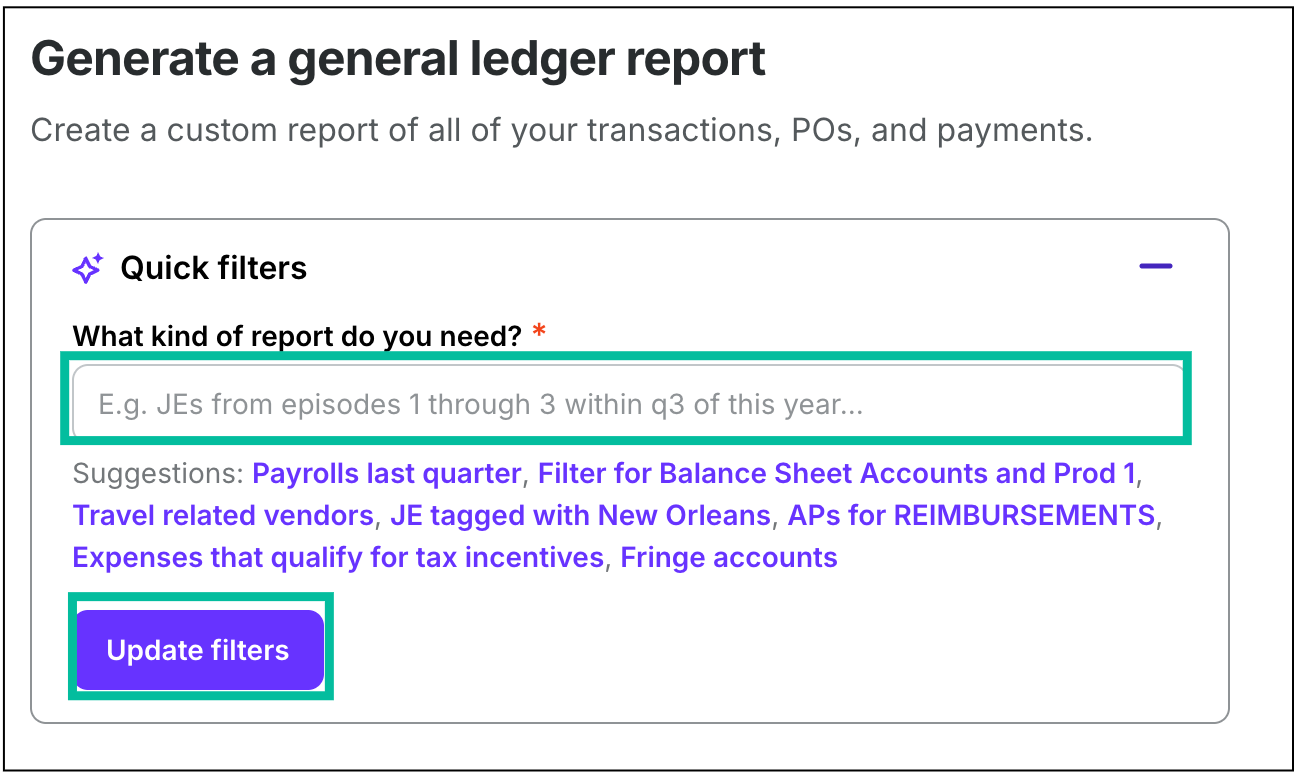
Enter a description of the GL information you want in the report, and then click the Update filters button
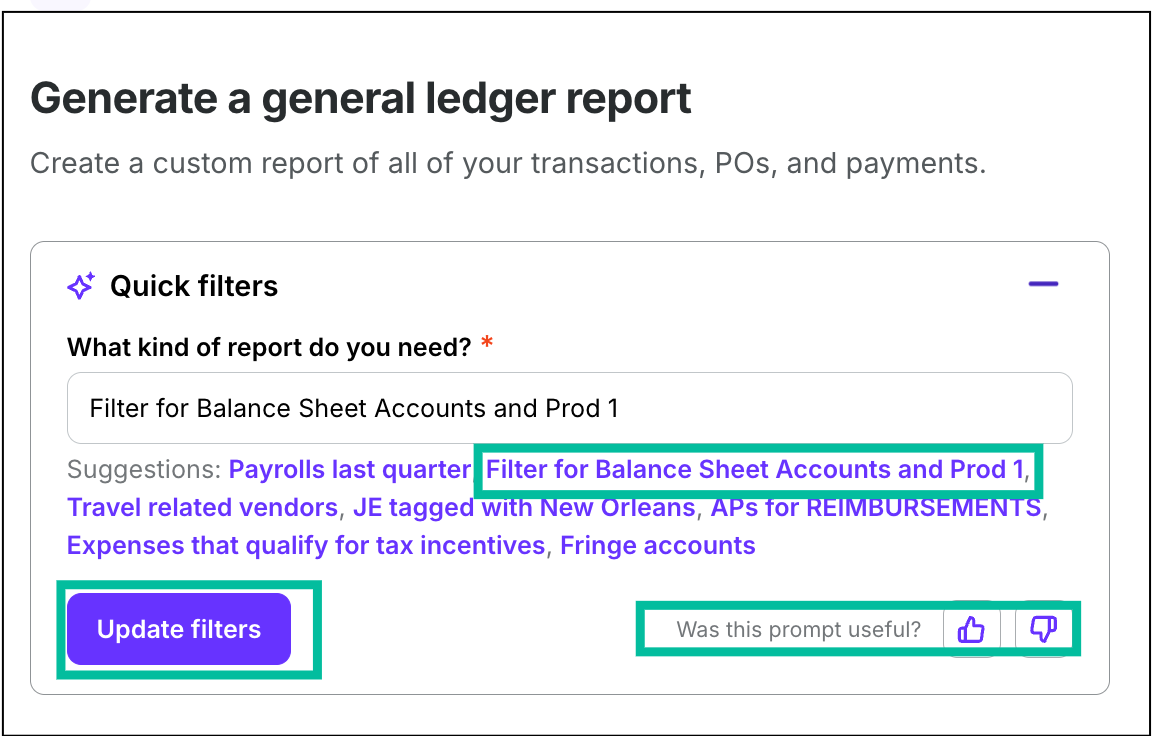
Or you can click on one of the Suggestions. To provide feedback on prompt suggestions, click either of the thumbs up/thumbs down icons.
Quick filter tips
The Quick filters section can process most natural language queries that are based on the following filters:
Tags
Location
Production/Episode
Account codes
Transaction numbers
Period/Effective date
Transaction type
Vendor information
The Quick filters feature works best when you’re specific about the information you're looking for. Be sure to include relevant dates, periods, or account codes in your query.
Here’s some examples of requests you can make:
Show me all transactions for vendor Home Depot
Display all qualified expenses in Louisiana
What transactions occurred in the previous period?
Show me all post-production costs
GL report manual filters
If you don’t want to use the Quick filters, you can use the Apply filters section of the General ledger report page to manually select filters.
Click the arrow to see the full list of manual filters for GL reports
Filter | Description |
|---|---|
From effective date & To effective date | Define the period range |
Transaction type | Options: Accounts Payable (AP), Journal Entry (JE), Payroll (PR), Vendor Payment (VP), Open Purchase Order (Open PO) |
Transaction start date & Transaction end date | Select the timeframe for transactions |
From Transaction # & To transaction # | Select a range of transactions based on their reference number |
From PO # & To PO # | Select a range of purchase orders based on their reference number |
Transaction status | Options: Posted (default), Unposted, All statuses |
Cancelled | Options: Include (default), Exclude, Only |
Posted start date & Posted end date | Select a range of transactions based on the date they were posted |
Vendor | Select the vendors that you want to see transactions for. If you don’t see a vendor in the list, you’ll need to go to the Vendors page and add them before you can select them as a filter. |
V1099 | Select the vendors with US tax form 1099s that you want to see transactions for |
From ACCT & To ACCT | Select the account numbers that you want to see transactions for |
Specific accounts | Click to select account numbers |
Account type | Options: Asset, Liability, Expense, Income, and Equity |
LO | Select the work locations that you want to see transactions for. If you don’t see a location in the list, you’ll need to go to Project settings, Accounting section and add it to your project’s Tags. |
PRD | Select the production numbers that you want to see transactions for. If you don’t see a production number in the list, you’ll need to go to Project settings, Accounting section and add it to your project’s Tags. |
SET | Select the set numbers that you want to see transactions for. If you don’t see a set number in the list, you’ll need to go to Project settings, Accounting section and add it to your project’s Tags. |
FF1 | This is a free field that you can use to add a custom filter |
1099 | Click to select the 1099 category |
Asset | Choose if you want to see transactions for production assets |
Description contains | Select transactions that have specific words in their transaction descriptions |
Line amount minimum & Line amount maximum | Select a range of transactions based on their individual dollar amounts |
Include distribution changes | Click the checkbox to show distribution changes made, un-click the checkbox to hide them completely |
Include starting/ending balances | Click the checkbox to show the starting/ending balances for the period range selected, un-click the checkbox to hide it |
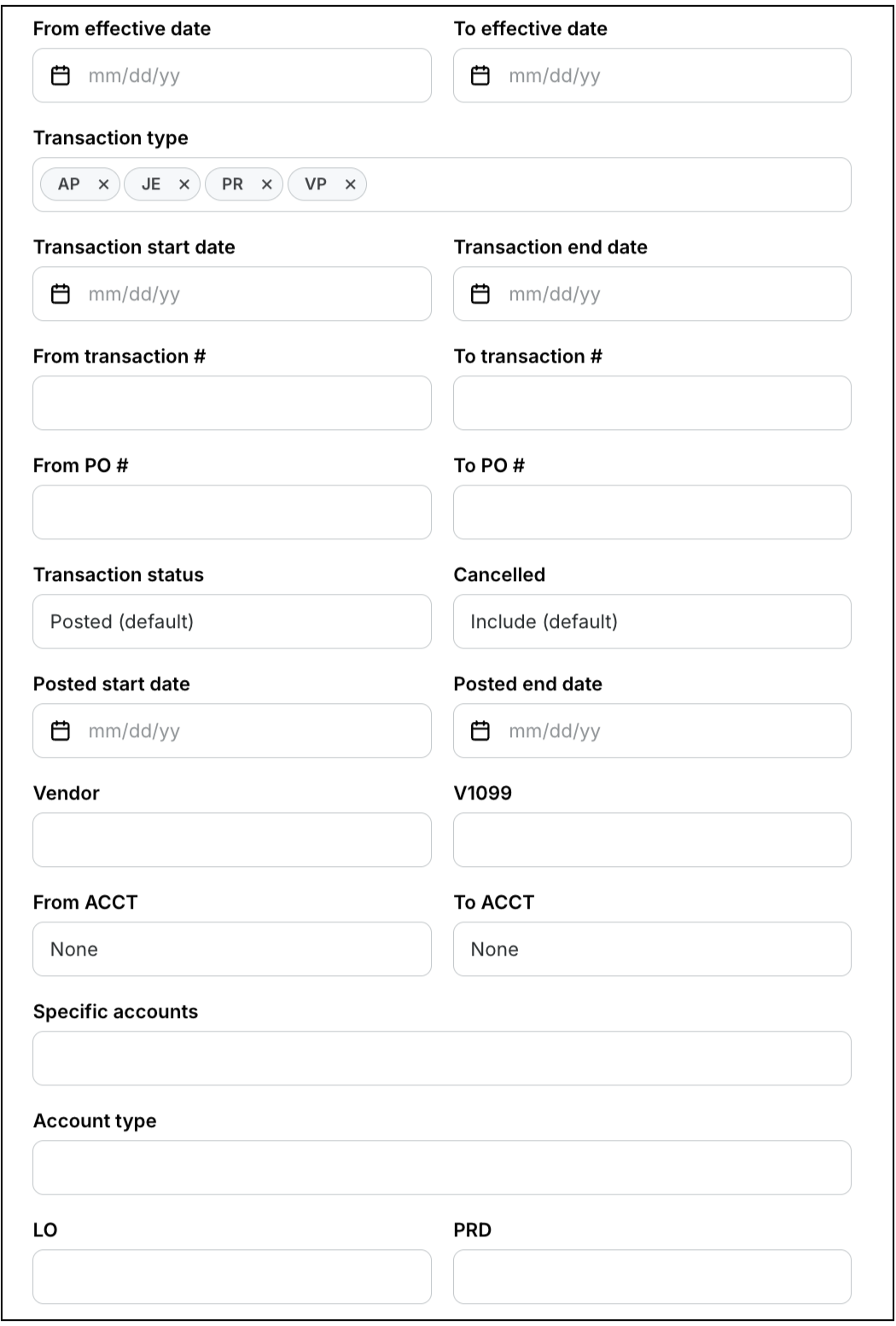
Screenshot of the manual filters available on the Generate a general ledger report page
GL report settings
Before you generate a GL report, you’ll be required to enter the following information in the Report settings section:
Report name
Report type (Detail or Summary)
Group by (Account code, Account type, Transaction vendor, Line vendor, Transaction type, Transaction #, Ref # Tag (LO), Tag (PRD), Tag (SET), Tag (FF1), Ungrouped)
Export format (PDF or CSV)
Page size (Letter, Legal, Ledger/RA3 or 2x Ledger/RA2)
Show Thousands separator
If you want to display a thousands separator on your GL report, click to enable this option
Edit report columns
You can choose the columns that you want to show or hide in your GL report by doing the following:
In the GL Report settings, click the Edit report columns button at the bottom of the section
In the popup, click to select/de-select the checkboxes next to any of the column headers listed
Click the Save button
.png)
Click the Edit report columns button
.png)
In the popup, click the checkboxes to select the columns that you want to show in the GL report. To hide a column, click to de-select its checkbox. When you’re ready, click the Save button.
Preview your GL report
In the Report preview, you can see the types of data that will appear in the report based on the filters and settings you’ve applied.
Generate your GL report
On the General ledger report page, click the Generate report button
After you click the button, your report will begin automatically downloading to your computer. You’ll receive an email once it’s ready.
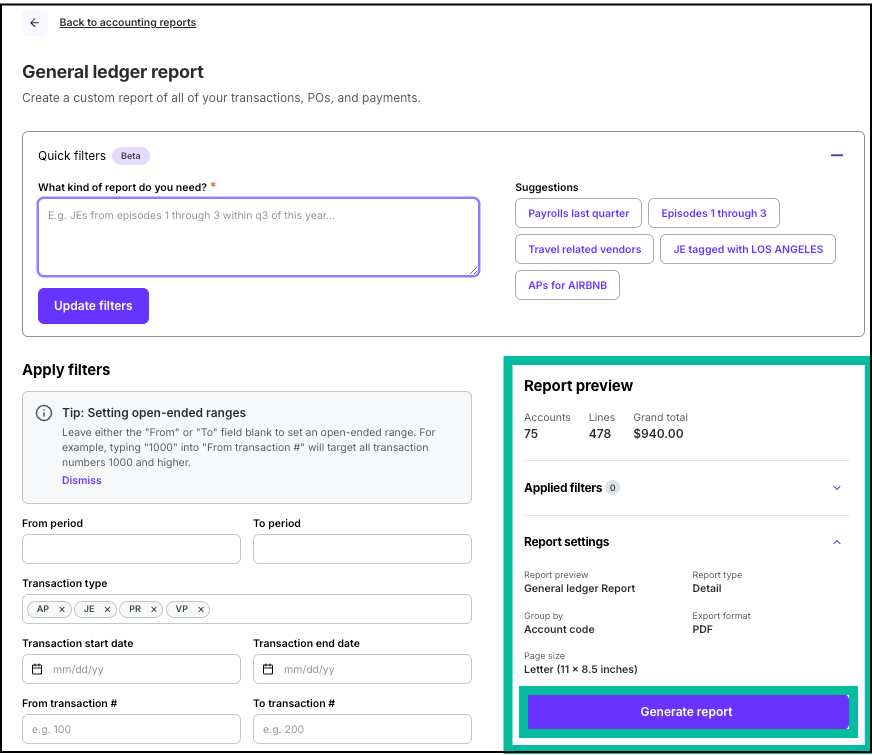
Example of a GL Report preview. Click the Generate report button to begin your download.
.png)
Example of a GL report generated in Wrapbook
Create a GL report template
Report templates allow you to save your preferred settings for your GL reports. Instead of adjusting settings every time you generate a report, you can create and save templates for quick access to your preferred views.
Create a template
In the left-side navigation, click the dropdown menu
In the dropdown menu, select the project that you want to create a GL report template for
In the left-side navigation, expand the ACCOUNTING menu and then click Accounting reports
On the Accounting reports dashboard, click the Create report button next to General Ledger
In the Apply filters section, add the filters that you want to use for your report template. Use the Report preview to see an overview of what will be included in the report.
Once you are satisfied with the way the report is configured, click the Create template button
In the Create template popup, enter a template Name. You can click the checkbox to Set as default (optional)
Click the Save button
The template that you’ve just created will now appear as an option in the Custom template dropdown menu when you return to the Generate report page. If you set the template to be the default, it will automatically be selected in the dropdown menu.
.png)
Select a project, click Accounting reports, then click the Create report button next to General ledger
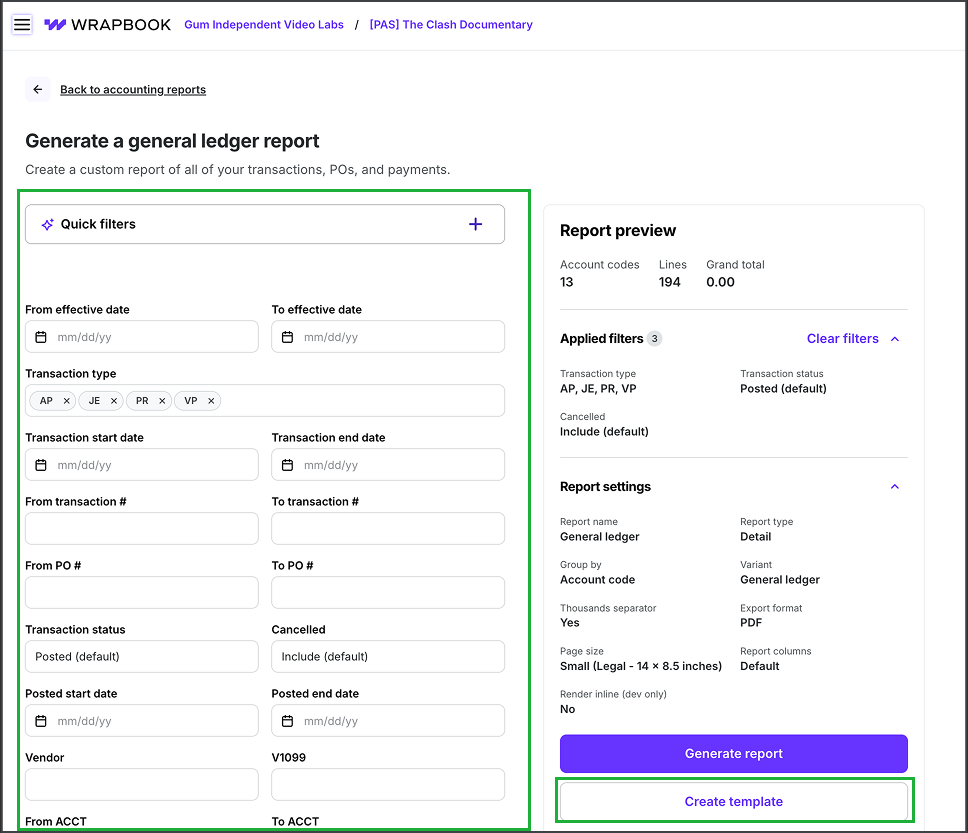
Click to apply filters, then click the Create template button
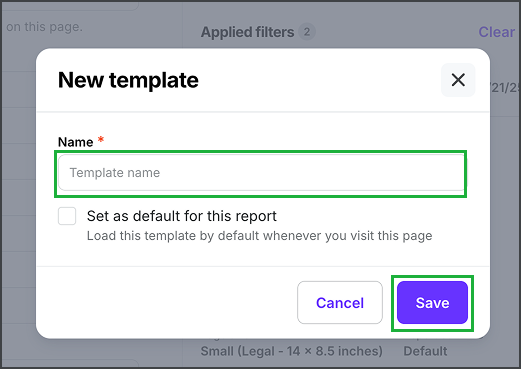
Enter a Name, click to Set as default for this report (optional), and then click the Save button

A notification will appear confirming that your template has been saved
Set as default, rename, duplicate, or delete an existing template
Once a template has been created, you can set it as the default, update its name, duplicate it, or delete it using the following steps:
In the left-side navigation, click the dropdown menu
In the dropdown menu, select the project that you want to update a GL report template for
In the left-side navigation, expand the ACCOUNTING menu and then click Accounting reports
On the Accounting reports dashboard, click the Create report button next to General Ledger
On the Generate a general ledger report page, under Templates, click the dropdown menu to select the template that you want to update
Click the gear icon, and then select an option: Set as default, Rename, Duplicate, or Delete
.png)
Select a project, click Accounting reports, then click the Create report button next to General ledger

Select the template, click the gear icon, and then make your selection
Updating a template
If you make changes to a template, a Save changes button will appear next to the template’s name
To preserve the changes be sure to click the Save changes button before running a report or leaving the page

Click the Save changes button to update the template